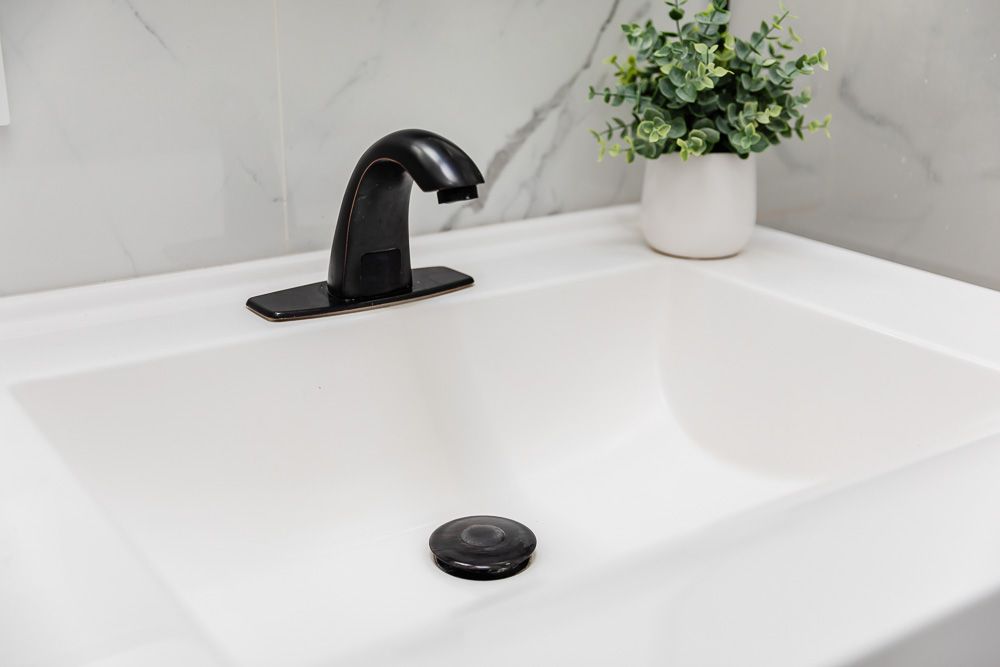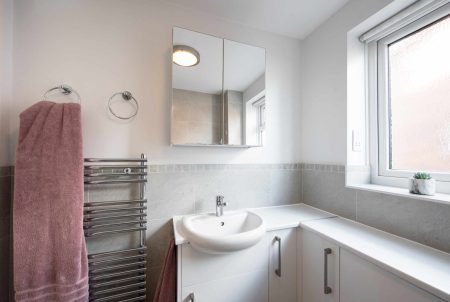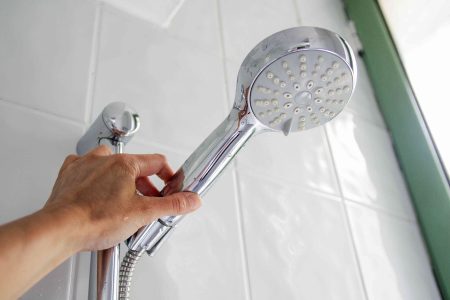The drain stopper apparatus for most bathroom sink drains is a pop-up assembly with a small vertical rod attached to a pivot rod below the sink. This lift rod slides up and down through a small hole in the back of the faucet body. The pivot rod moves a linkage inside the drain tailpiece, lifting or lowering the stopper as needed.
You’ll need to install a new drain stopper whenever installing a new sink. And sometimes, when installing a new faucet, it may come with a stopper assembly that needs to be swapped out with the old stopper. If a sink drain begins to leak, you can buy a new stopper assembly to replace the old faulty one.
Installation of a drain stopper is usually relatively straightforward, but occasionally the process can become a little more complicated due to variations in the fixture or fittings.
Before You Begin
Always shut off the water before beginning any plumbing work. The shut-off valves (round or oval-shaped knobs, usually one for hot and another for cold) are located under the sink.
You can choose different types of stoppers, finishes, and construction materials. Consider the aesthetic and functionality you prefer.
Sink Stopper Finishes
Sink stoppers are available in different metal finishes for the visible drain ring and stopper to match your faucet hardware. The lower drain assembly can be made of durable metal or less expensive plastic. Professional plumbers sometimes feel that metal assemblies are preferable. Still, plastic pop-up assemblies are generally acceptable for DIYers, though they can be slightly prone to breakage if you over-tighten the nuts during installation.
Traditional vs. Spring-Loaded Sink Stoppers
Traditional pop-up stoppers use a lift rod, pivot rod, and internal ball to lift and lower the stopper. Spring-loaded sink stoppers have none of these pivot parts. These stoppers are worth considering, as they are pretty easy to install.
Spring-loaded stoppers resemble the drain stopper that is very popular for bathtubs. These spring-loaded stoppers open and close simply by pushing down on the stopper from inside the sink; one push down causes the stopper to lock in the closed position, and the subsequent push releases the stopper and allows the internal spring to push it back up to the open position. The disadvantage to this stopper type is it requires the user to reach through standing water to release the stopper and drain the sink.
Watch Now: How to Install a Pop-Up Drain Stopper
What You’ll Need
Equipment / Tools
- Bucket
- Channel-type pliers
Materials
- Pop-up drain assembly
- Pipe joint compound
- Plumber’s putty
Instructions
Instructions
-
Remove the Old Drain Assembly
Loosen and remove the P-trap from the branch drain and sink drain tailpiece using channel-type pliers. With some traps, you may be able to loosen and remove the trap by hand without a wrench. There may be some water in the trap, so position a bucket under the trap to catch it.
- Extract the old pop-up linkage assembly, if there is one.
- Use channel-type pliers to remove the mounting nut from the tailpiece on the old drain assembly.
- Lift the entire drain assembly clear of the sink. This may require some wiggling of the tailpiece to break the seal on the drain flange.
- With the drain assembly removed, clean the sink thoroughly of debris and old plumber’s putty.
-
Prepare the New Pop-Up Drain Stopper
- Disassemble the new pop-up assembly pieces.
- Unscrew and remove the mounting nut from the drain tailpiece.
- Install the plastic and rubber washers; push them down on top of the mounting nut (as pictured).
-
Apply Pipe Joint Compound
Apply a thin layer of pipe joint compound to the top side of the rubber washer that will fit against the sink.
Using joint compound at the joint will ensure it seals against the bottom of the sink drain opening. Pipe joint compound is optional, but you might have trouble getting the rubber to seal without it.
-
Apply Plumber’s Putty
Apply a generous bead of plumber’s putty to the underside of the flange on the sink drain ring. The putty will help the upper part of the drain assembly seal against the sink drain opening.
An alternative to plumber’s putty is silicone caulk. Some pop-up assemblies come with a foam or rubber gasket to use instead of a plumber’s putty or caulk.
-
Connect the Drain Parts
- Push the pop-up drain tailpiece assembly up through the drain opening from under the sink as high as possible.
- While holding the drain piece in place, fit the drain ring into the opening from above the sink, and thread the ring onto the drain tailpiece as far as you can by hand.
- Take care to thread it correctly, and do not cross-thread it. It only needs to be hand-tightened to hold it in place.
-
Tighten the Drain Assembly
- From under the sink, hold the drain tailpiece motionless with one hand and tighten the mounting nut upwards toward the bottom of the sink. Make sure the opening in the tailpiece (where the pop-up pivot lever will fit) is pointing straight back toward the wall.
- Tighten the mounting nut with channel-type pliers while holding the tailpiece in place. Do not over-tighten the nut; secure it so the drain assembly does not spin in the drain opening.
-
Put the Drain Stopper Into Place
- Insert the pop-up stopper into the drain opening inside the sink, ensuring the linkage hole faces toward the sink’s back.
- From under the sink, insert the pivot rod into the opening in the side of the tailpiece. Usually, there is a plastic washer on each side of the plastic ball. You should be able to feel the tip of the pivot rod slide through the opening in the stopper linkage inside the drain assembly.
- Screw the pivot rod nut onto the threaded fitting on the side of the tailpiece so the ball is secured inside the tailpiece.
- Test the pivot rod’s action to ensure the stopper goes up and down freely in the drain.
- If the pop-up is working properly, tighten the nut hand tight.
- If the pop-up is not working, reposition the stopper and pivot rod so the pieces connect properly.
- If the pop-up assembly is hard to move when you move the pivot rod, the pivot rod nut has been tightened down too much and needs to be slightly loosened.
-
Install the Pop-Up Lever
- Feed the vertical pop-up lever through the hole behind the faucet’s spout.
- Make sure your stopper is in the fully up (open) position before connecting the horizontal pivot rod to the vertical lever,
- From below the sink, attach the connecting strap to the end of the vertical pop-up lever.
- Tighten the screw on the connecting strap to secure it to the pivot rod.
-
Connect the Pop-Up Lever and Pivot Rod
- Connect the vertical strap to the horizontal pivot rod by threading the spring clip onto the rod; one end of the clip attaches to each side of the strap.
- Ensure that the pop-up stopper opens and closes fully inside the drain opening.
- Adjust the rod connections by pinching and moving the spring clip if it doesn’t.
-
Reassemble the Drain Trap
- Reconnect the P-trap to the drain pipe and drain tailpiece.
- Check for leaks by closing the stopper, filling up the sink, then opening the stopper and letting the water drain out while you look for leaks from below.
- Connections that leak can be slightly tightened with channel-type pliers, but do not over-tighten them.
When to Call a Professional
It’s advisable to call a plumber to handle this task if you’re not comfortable taking apart plumbing. You should also consider calling a professional if your pipes are very old. The plumbing in older homes tends to be more fragile and can get corroded. It is not unusual for old pipes to become brittle and break, resulting in more costly repairs than expected.
-
Should I use plumber’s putty on a sink drain?
Plumber’s putty is commonly used to seal along the base of faucets and other sink fixtures before setting them onto the sink. It’s not an adhesive but a barrier, giving a watertight seal. It remains soft, not hardening, chipping, or crumbling over time. Place it thick where the two parts will meet, fit the two pieces together, and wipe away the excess.
-
Can I replace just the sink stopper?
Yes. If there’s an issue only with the stopper, you can replace it with a new one. Many DIYers can accomplish this task without having to call in the pros.
-
What is the purpose of a sink stopper?
Sink stoppers can be lowered to stop water and allow the sink to fill. And when they’re raised, they allow water to drain and flow through the sink’s plumping.
-
Are sink stoppers universal?
A standard bathroom sink drain size is 1 1/2 inches across. However, drains can be larger or smaller, so selecting a sink stopper that fits your specific drain is essential.
Read the full article here














